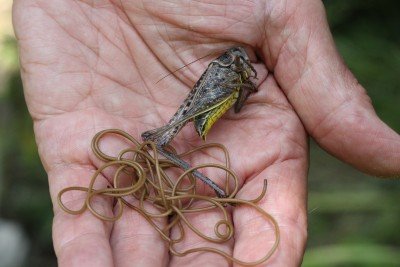
In this article, I’ll walk you through the essential details about **wolf worm identification**. You’ll learn how to spot these pesky parasites and understand their impact on wildlife. So grab your favorite beverage, settle in, and let’s untangle this topic. Like uncovering a hidden treasure, the more you know, the better prepared you’ll be when faced with these situations in the field.
What Are Wolf Worms?
Wolf worms, or **Cuterebra** larvae, are a type of botfly that primarily affects wild animals, especially rodents and rabbits. Picture these tiny invaders as unwelcome houseguests, settling into their hosts and causing quite a bit of chaos. Once laid, the eggs hatch and the larvae burrow into the skin of an unsuspecting animal, often leading to severe irritation and infections.
You might be thinking, “Why should I care about wolf worms?” If you’re involved in wildlife rescue, understanding these parasites is crucial. The sooner you can identify them, the better your chances are of treating the affected animal and preventing further suffering.
Identifying Wolf Worms: Signs and Symptoms
When it comes to wolf worm identification, knowing the signs to look for is key. Affected animals often display a range of symptoms that can clue you in on their trouble. Common signs include:
- Skin lesions: You might notice swollen lumps or sores on the skin where the larvae have entered. These lesions can become inflamed and infected if left untreated.
- Behavioral changes: An animal that is usually lively may start acting lethargic or withdrawn. They might avoid movement because of discomfort.
- Difficulty eating: If an animal has a mouth or throat infestation, it may struggle to eat, leading to weight loss and further health concerns.
If you see these signs, it’s time to act. Consider how best to approach the situation. Sometimes, the best course of action is to trap the animal and bring it back for professional help.
How to Diagnose Wolf Worm Infestation
Diagnosing a wolf worm infestation goes beyond just visual inspection. While observing the signs I mentioned earlier is important, the best way to confirm the presence of wolf worms is through careful examination. Gently inspecting the animal’s skin can reveal the larvae beneath the surface.
Here’s a handy approach to diagnosing an infestation:
- Visual inspection: Look for any swelling or holes in the skin. Check for the characteristic **breathing hole**, a small opening where the larva emerges to get air.
- Gentle palpation: If you can, gently press around the lump to feel for movement. If you can feel something squirming beneath the skin, it’s likely a wolf worm.
- Consult a vet: If you’re unsure, never hesitate to seek professional assistance. A veterinarian can provide a precise diagnosis and recommend proper treatment.
Remember, diagnosing these infestations early can dramatically improve recovery outcomes for wildlife.
Treatment Options for Wolf Worm Infestations
Once you identify a wolf worm infestation, the next step is treatment. You may wonder what options are available. Treatment usually involves either manually removing the larvae or having a veterinarian handle it.
Here’s a closer look at the treatment process:
- Manual extraction: If you’re experienced and confident, you might attempt to remove the larva yourself. Use sterilized tools to carefully extract the worm without causing further damage.
- Veterinary intervention: For many, it’s safer to let a professional handle the situation. They can provide medications, pain relief, and ensure the animal is stable throughout the process.
- Aftercare: Post-removal, it’s crucial to monitor the animal for signs of infection and ensure proper healing. This phase is vital for recovery.
Each animal’s situation is unique, so adapting your approach based on their condition is important.
Prevention Strategies for Wildlife Rescues
Preventing wolf worm infestations is always the best approach. It’s like locking your doors to keep unwanted guests out. Here are some strategies to consider:
- Habitat management: Keeping areas clean and reducing shelters for potential hosts can lower the risk of infestations.
- Regular monitoring: Keep an eye on the health of the animals you rescue. Early detection of any irregular behavior can lead to timely intervention.
- Education: Share knowledge with other wildlife rescuers and people in your community to raise awareness about wolf worm signs and treatment.
By implementing these strategies, you can greatly reduce the chances of infestations within the wildlife you care for.
The Importance of Reporting Findings
If you encounter wolf worms during your rescue efforts, reporting your findings is crucial. Not only does this help local wildlife authorities track larval outbreaks, but it also contributes to wider conservation efforts.
Here’s why reporting matters:
- Data collection: Your observations can help local wildlife agencies understand the prevalence of wolf worms in your area and develop strategies to combat them.
- Community education: The more people know about these pests, the better equipped they’ll be to handle them in the future.
- Conservation efforts: When wildlife organizations know about infestations, they can initiate larger projects to protect affected animal populations.
So, think of yourself not just as a rescuer but a guardian for local wildlife.
Understanding **wolf worm identification** is essential for anyone involved in rural wildlife rescue. By being able to spot the signs, diagnose infestations, and provide the right treatment, you become a crucial player in protecting these creatures. Remember that your actions can save lives and improve overall animal welfare in your community.
From proper treatment to preventive measures, every step you take adds up to a significant impact. Stay informed, observe carefully, and don’t hesitate to reach out for help when needed. Together, we can create a safer environment for our wildlife friends.
